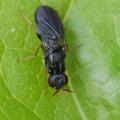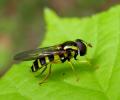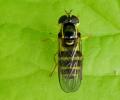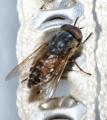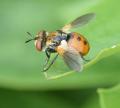Who is here? 1 guest(s)
|
Phryxe nemea
|
|
| Robert Heemskerk |
Posted on 12-02-2008 23:35
|
|
Member Location: Posts: 2082 Joined: 17.10.05 |
Hi flyforum, On 3-02 I found a larvae of Phlogophora meticulosa, in bad condition. The larvae was in the latest stadium before it becomes a cocon(I think so) I collected it in a box and after some days I concluded that the transformation was unsuccessful. Looking better to this dead caterpillar I found two cocons. Phryxe nemea could be parasite-guest? But in wintertime? Does the Phlogophora meticulosa have these parasite-eggs? or larvae on itsself during wintertime? Or is this fly active during wintertime? Edited by Robert Heemskerk on 12-02-2008 23:36 Greeting, Robert Heemskerk ---- WWW: http://robertheem...ndedag.htm --- |
|
|
|
| jorgemotalmeida |
Posted on 13-02-2008 13:49
|
|
Member Location: Posts: 9295 Joined: 05.06.06 |
there are other two parasitoids, at least, besides Phryxe nemea. They are Phryxe vulgaris Siphona cristata Very probably there are much more tachinids. |
|
|
|
| Robert Heemskerk |
Posted on 26-02-2008 23:08
|
|
Member Location: Posts: 2082 Joined: 17.10.05 |
One of these flies left the cocon. Seems Phryxe nemea (male) to me, but I don't have any experience with other Phryxe sp.. Edited by Robert Heemskerk on 26-02-2008 23:09 Greeting, Robert Heemskerk ---- WWW: http://robertheem...ndedag.htm --- |
|
|
|
| Robert Heemskerk |
Posted on 26-02-2008 23:10
|
|
Member Location: Posts: 2082 Joined: 17.10.05 |
Dorsal view
Edited by Robert Heemskerk on 26-02-2008 23:10 Greeting, Robert Heemskerk ---- WWW: http://robertheem...ndedag.htm --- |
|
|
|
| ChrisR |
Posted on 27-02-2008 13:30
|
|
Administrator Location: Posts: 7699 Joined: 12.07.04 |
I'd be happy with that  (Assuming I haven't missed something obvious that Theo will point out to me and it keys to Phryxe (Assuming I haven't missed something obvious that Theo will point out to me and it keys to Phryxe  )The mustard-coloured dusting on the parafrontal region and wide separation between the parafacial and facial-ridge bristles strongly indicates this )The mustard-coloured dusting on the parafrontal region and wide separation between the parafacial and facial-ridge bristles strongly indicates this  |
|
|
|
| Robert Heemskerk |
Posted on 28-02-2008 21:15
|
|
Member Location: Posts: 2082 Joined: 17.10.05 |
Thank you Chris, Here one other picture, to illustrate the mustard-coloured dusting on the parafrontal region. The other flie didn't succeed, I think something went wrong when sneaking out.. Edited by Robert Heemskerk on 28-02-2008 21:15 Greeting, Robert Heemskerk ---- WWW: http://robertheem...ndedag.htm --- |
|
|
|
| Robert Heemskerk |
Posted on 28-02-2008 21:16
|
|
Member Location: Posts: 2082 Joined: 17.10.05 |
not succesful..
Edited by Robert Heemskerk on 28-02-2008 21:17 Greeting, Robert Heemskerk ---- WWW: http://robertheem...ndedag.htm --- |
|
|
|
| Zeegers |
Posted on 29-02-2008 11:04
|
|
Member Location: Posts: 18446 Joined: 21.07.04 |
Phryxe nemea sounds good. It is a female,though (the second one is male) Theo |
|
|
|
| Robert Heemskerk |
Posted on 29-02-2008 11:47
|
|
Member Location: Posts: 2082 Joined: 17.10.05 |
thank you Theo, just for the little details:  Looking at the single, long and strong bristles on the frontal head (pic 2,3,4), I thought this was a male? Picture 4 got a false (flashlight)shadow on the head, so singlehairs may look double? The other fly(on pic 5), could be male too? (not developed completely) I'll place two detailes pictures of the frontal heads of the two flies underneath: fly 1) Edited by Robert Heemskerk on 29-02-2008 11:51 Greeting, Robert Heemskerk ---- WWW: http://robertheem...ndedag.htm --- |
|
|
|
| Robert Heemskerk |
Posted on 29-02-2008 11:48
|
|
Member Location: Posts: 2082 Joined: 17.10.05 |
fly 2)
Edited by Robert Heemskerk on 29-02-2008 11:49 Greeting, Robert Heemskerk ---- WWW: http://robertheem...ndedag.htm --- |
|
|
|
| Zeegers |
Posted on 01-03-2008 18:12
|
|
Member Location: Posts: 18446 Joined: 21.07.04 |
The first one has (2 pairs of) proclinate orbital setae, the second one doesn't, That makes the first one female, the seond male. General rule of thumb for most Tachinids. Theo |
|
|
|
| Robert Heemskerk |
Posted on 01-03-2008 18:47
|
|
Member Location: Posts: 2082 Joined: 17.10.05 |
Yep  , now I understand this. , now I understand this.thanx. Greeting, Robert Heemskerk ---- WWW: http://robertheem...ndedag.htm --- |
|
|
|
| Jump to Forum: |


